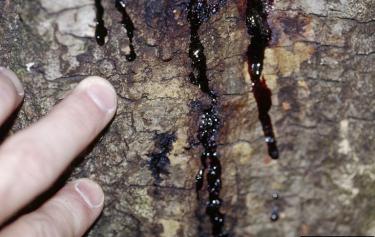When You Have an Outbreak
Some trees survive sudden oak death on their own, but there is no known cure. Instead, the goal is to keep Phytophthora ramorum, the fungus that causes sudden oak death, from spreading to healthy plants or new areas.
Alert authorities. If you live outside of the places where Phytophthora ramorum is known to have reached, officials will get involved to prevent its spread. While Phytophthora ramorum is not yet known in the wild outside of coastal counties in California in Oregon, some eastern oak species are known to be susceptible to it, and experts fear that it will spread through nurseries. A quick response is necessary to keep the fungus from gaining a destructive foothold in a new area.
Sanitation. Anyone who has been in an infected area should clean mud, dirt, and plant material off their shoes and vehicles before going to another place with susceptible plants. Also clean hands and tools thoroughly.
Fungicide. Applying a phosphonate fungicide approved for use against sudden oak death may help slow the disease in trees that are just starting to show symptoms. It's useless on trees with more advanced disease.
Insecticide. If an oak or tanoak is in the early stages of infection, applying an insecticide may help keep bark beetles from moving in and killing it off.
A local extension agent or forester can help you decide what to do if you have sudden oak death in your woods.
The best way to keep your trees safe is to avoid introducing the fungus that causes sudden oak death. Read more on the prevention page.
How can I get more tips?
It’s simple! Enter your email below.

